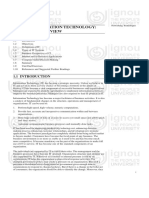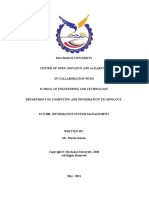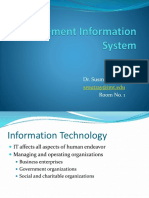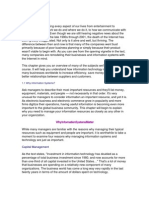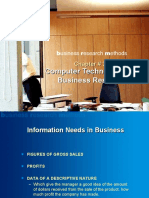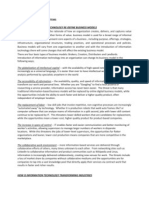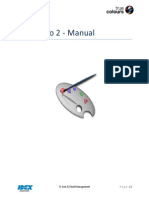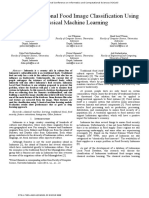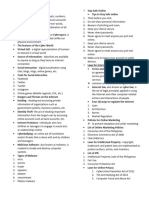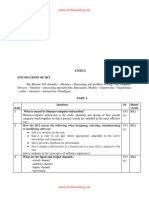Chapter 8.
Using Technology to Manage Information
This chapter focuses on the role of information technology (IT) in business, examining the details of MIS
organization, as well as the challenges companies encounter in an increasingly technological world.
Harnessing the power of information technology gives a company a significant competitive advantage.
Transforming Businesses through Information
How has information technology transformed business and managerial decision-making?
Information technology (IT) includes the equipment and techniques used to manage and process
information. Information is at the heart of all organizations. Without information about the processes
of and participants in an organization—including orders, products, inventory, scheduling, shipping,
customers, suppliers, and employees—a business cannot operate. In less than 70 years, we have shifted
from an industrial society to a knowledge-based economy driven by information. Businesses depend on
information technology for everything from running daily operations to making strategic decisions.
Computers are the tools of this information age, performing extremely complex operations as well as
everyday jobs such as word processing and creating spreadsheets. The pace of change has been rapid
since the personal computer became a fixture on most office desks. Individual units became part of
small networks, followed by more sophisticated enterprise-wide networks. Table 2 and Table 3
summarize the types of computer equipment and software, respectively, most commonly used in
business management information systems today.
1
�Tablo 1 Equipments
2
�Tablo 2 Applications Types and Usage
Although most workers spend their days at powerful desktop computers, other groups tackle massive
computational problems at specialized supercomputer centers. Tasks that would take years on a PC can
be completed in just hours on a supercomputer. With their ability to perform complex calculations
quickly, supercomputers play a critical role in national security research, such as analysis of defense
intelligence; scientific research, from biomedical experiments and drug development to simulations of
earthquakes and star formations; demographic studies such as analyzing and predicting voting patterns;
and weather and environmental studies. Businesses, too, put supercomputers to work by analyzing big
data to gain insights into customer behavior, improving inventory and production management and for
product design.
The speed of these special machines has been rising steadily to meet increasing demands for greater
computational capabilities, and the next goal is quadrillions of computations per second, or petaflops.
Achieving these incredible speeds is critical to future scientific, medical, and business discoveries. Many
3
�countries, among them the United States, China, France, and Japan, have made petascale computing a
priority.
In addition to a business’s own computers and internal networks, the internet makes it effortless to
connect quickly to almost anyplace in the world. As Thomas Friedman points out in his book The World
Is Flat, “We are now connecting all of the knowledge centers on the planet together into a single global
network, which . . . could usher in an amazing era of prosperity and innovation.”3 The opportunities for
collaboration on a global scale increase daily. A manager can share information with hundreds of
thousands of people worldwide as easily as with a colleague on another floor of the same office building.
The internet and the web have become indispensable business tools that facilitate communication
within companies as well as with customers.
The rise of electronic trading hubs is just one example of how technology is facilitating the global
economy. Electronic trading hubs are not reserved for large companies of developed economies,
however. Alibaba is piloting an e-hub called eWTP in Malaysia that will provide access to small
businesses. As Jack Ma, Alibaba cofounder, said at eWTP’s launch, “There are a lot of free-trade zones
for efficient trade facilitation, but only for big companies. There is no free-trade zone designed for small
companies. I have been shouting everywhere, screaming, that every government should do it.”
Data and Information Systems
Information systems and the computers that support them are so much a part of our lives that we
almost take them for granted. These management information systems methods and equipment that
provide information about all aspects of a firm’s operations provide managers with the information they
need to make decisions. They help managers properly categorize and identify ideas that result in
substantial operational and cost benefits.
Businesses collect a great deal of data—raw, unorganized facts that can be moved and stored—in their
daily operations. Only through well-designed IT systems and the power of computers can managers
process these data into meaningful and useful information and use it for specific purposes, such as
making business decisions. One such form of business information is the database, an electronic filing
system that collects and organizes data and information. Using software called a database management
system (DBMS), you can quickly and easily enter, store, organize, select, and retrieve data in a database.
These data are then turned into information to run the business and to perform business analysis.
Databases are at the core of business information systems. For example, a customer database
containing name, address, payment method, products ordered, price, order history, and similar data
provides information to many departments. Marketing can track new orders and determine what
products are selling best; sales can identify high-volume customers or contact customers about new or
related products; operations managers use order information to obtain inventory and schedule
production of the ordered products; and finance uses sales data to prepare financial statements. Later
in the chapter, we will see how companies use very large databases called data warehouses and data
marts.
Companies are discovering that they can’t operate well with a series of separate information systems
geared to solving specific departmental problems. It takes a team effort to integrate the systems
described and involves employees throughout the firm. Company-wide enterprise resource planning
(ERP) systems that bring together human resources, operations, and technology are becoming an
integral part of business strategy. So is managing the collective knowledge contained in an organization,
using data warehouses and other technology tools. Technology experts are learning more about the
4
�way the business operates, and business managers are learning to use information systems technology
effectively to create new opportunities and reach their goals.
Enterprise Portals Open the Door to Productivity
Intranets that take a broader view serve as sophisticated knowledge management tools. One such
intranet is the enterprise portal, an internal website that provides proprietary corporate information to
a defined user group. Portals can take one of three forms: business to employee (B2E), business to
business (B2B), and business to consumer (B2C). Unlike a standard intranet, enterprise portals allow
individuals or user groups to customize the portal home page to gather just the information they need
for their particular job situations and deliver it through a single web page. Because of their complexity,
enterprise portals are typically the result of a collaborative project that brings together designs
developed and perfected through the effort of HR, corporate communications, and information
technology departments.
More companies use portal technology to provide:
• A consistent, simple user interface across the company
• Integration of disparate systems and multiple sets of data and information
• A single source for accurate and timely information that integrates internal and external information
• A shorter time to perform tasks and processes
• Cost savings through the elimination of information intermediaries
• Improved communications within the company and with customers, suppliers, dealers, and
distributors
Wireless Technologies
Wireless technology has become commonplace today. We routinely use devices such as cellular
phones, mobile devices, garage door openers, and television remote controls—without thinking of
them as examples of wireless technology. Businesses use wireless technologies to improve
communications with customers, suppliers, and employees.
Companies in the package delivery industry, such as UPS and FedEx, were among the first users of
wireless technology. Delivery personnel use handheld computers to send immediate confirmation of
package receipt. You may also have seen meter readers and repair personnel from utility and energy
companies send data from remote locations back to central computers. Bluetooth short-range wireless
technology is a global standard that improves personal connectivity for users of mobile phones, portable
computers, and stereo headsets, and Bluetooth wirelessly connects keyboards and mice to computers
and headsets to phones and music players. A Bluetooth-enabled mobile phone, for example, provides
safer hands-free phone use while driving. The technology is finding many applications in the auto
industry as well. Bluetooth wireless technology is now standard in many vehicles today. Many car,
technology, and cell phone companies—among them Amazon, Apple, Audi, BMW, DaimlerChrysler,
Google, Honda, Saab, Toyota, and Volkswagen—already offer Bluetooth hands-free solutions. Other
uses include simplifying the connection of portable digital music players to the car’s audio system and
transferring downloaded music to the system.
5
�Management Information Systems
Whereas individuals use business productivity software such as word processing, spreadsheet, and
graphics programs to accomplish a variety of tasks, the job of managing a company’s information needs
falls to management information systems: users, hardware, and software that support decision-making.
Information systems collect and store the company’s key data and produce the information managers
need for analysis, control, and decision-making.
Factories use computer-based information systems to automate production processes and order and
monitor inventory. Most companies use them to process customer orders and handle billing and vendor
payments.
Banks use a variety of information systems to process transactions such as deposits, ATM withdrawals,
and loan payments. Most consumer transactions also involve information systems. When you check out
at the supermarket, book a hotel room online, or download music over the internet, information
systems record and track the transaction and transmit the data to the necessary places.
Companies typically have several types of information systems, starting with systems to process
transactions. Management support systems are dynamic systems that allow users to analyze data to
make forecasts, identify business trends, and model business strategies. Office automation systems
improve the flow of communication throughout the organization.
Decision Support Systems
A decision support system (DSS) helps managers make decisions using interactive computer models that
describe real-world processes. The DSS also uses data from the internal database but looks for specific
data that relate to the problems at hand. It is a tool for answering “what if” questions about what would
happen if the manager made certain changes. In simple cases, a manager can create a spreadsheet and
try changing some of the numbers. For instance, a manager could create a spreadsheet to show the
amount of overtime required if the number of workers increases or decreases. With models, the
manager enters into the computer the values that describe a particular situation, and the program
computes the results. Marketing executives at a furniture company could run DSS models that use sales
data and demographic assumptions to develop forecasts of the types of furniture that would appeal to
the fastest-growing population groups. Companies can use a predictive analytics program to improve
their inventory management system and use big data to target customer segments for new products
and line extensions.
Protecting Computers and Information
Have you ever lost a term paper you worked on for weeks because your hard drive crashed or you
deleted the wrong file? You were upset, angry, and frustrated. Multiply that paper and your feelings
hundreds of times over, and you can understand why companies must protect computers, networks,
and the information they store and transmit from a variety of potential threats. For example, security
breaches of corporate information systems—from human hackers or electronic versions such as viruses
and worms—are increasing at an alarming rate. The ever-increasing dependence on computers requires
plans that cover human error, power outages, equipment failure, hacking, and terrorist attacks. To
withstand natural disasters such as major fires, earthquakes, and floods, many companies install
specialized fault-tolerant computer systems.
Disasters are not the only threat to data. A great deal of data, much of it confidential, can easily be
tapped or destroyed by anyone who knows about computers. Keeping your networks secure from
6
�unauthorized access—from internal as well as external sources—requires formal security policies and
enforcement procedures. The increasing popularity of mobile devices—laptops, tablets, and cell
phones—and wireless networks requires new types of security provisions.
In response to mounting security concerns, companies have increased spending on technology to
protect their IT infrastructure and data. Along with specialized hardware and software, companies need
to develop specific security strategies that take a proactive approach to prevent security and technical
problems before they start.
Data Security Issues
Unauthorized access into a company’s computer systems can be expensive, and not just in monetary
terms. Juniper Networks estimates that cybercrime will cost businesses more than $3 trillion in 2020,
compared to just $2 trillion in 2019. The most costly categories of threats include worms, viruses, and
Trojan horses (defined later in this section); computer theft; financial fraud; and unauthorized network
access. The report also states that almost all U.S. businesses report at least one security issue, and almost
20 percent have experienced multiple security incidents.
Computer crooks are becoming more sophisticated all the time, finding new ways to get into ultra-
secure sites. “As companies and consumers continue to move towards a networked and information
economy, more opportunity exists for cybercriminals to take advantage of vulnerabilities on networks
and computers,” says Chris Christiansen, program vice president at technology research firm IDC.17
Whereas early cybercrooks were typically amateur hackers working alone, the new ones are more
professional and often work in gangs to commit large-scale internet crimes for large financial rewards.
The internet, where criminals can hide behind anonymous screen names, has increased the stakes and
expanded the realm of opportunities to commit identity theft and similar crimes. Catching such
cybercriminals is difficult, and fewer than 5 percent are caught.
Internet of Things (ioT) 1
“The IoT can be viewed as a global infrastructure for the information society, enabling advanced
services by interconnecting (physical and virtual) things based on existing and evolving interoperable
information and communication technologies).”
Things are objects of the physical world (physical things) or of the information world (virtual world)
which are capable of being identified and integrated into communication networks. Things have
associated information, which can be static and dynamic.
Physical things exist in the physical world and are capable of being sensed, actuated and connected.
Examples of physical things include the surrounding environment, industrial robots, goods and
electrical equipment.
Virtual things exist in the information world and are capable of being stored, processed and
accessed. Examples of virtual things include multimedia content and application software.
1
Marco Zennaro, “Introduction to the Internet of Things”,
7
�Fundamental characteristics of IOT
• Interconnectivity: With regard to the IoT, anything can be interconnected with the global
information and communication infrastructure.
• Heterogeneity: The devices in the IoT are heterogeneous as based on different hardware
platforms and networks. They can interact with other devices or service platforms through
different networks.
• Dynamic changes: The state of devices change dynamically, e.g., sleeping and waking up,
connected and/or disconnected as well as the context of devices including location and
speed. Moreover, the number of devices can change dynamically.
Enormous scale: The number of devices that need to be managed and that communicate
with each other will be at least an order of magnitude larger than the devices connected to
the current Internet. The ratio of communication triggered by devices as compared to
communication triggered by humans will noticeably shift towards devicetriggered
communication.
8
�Predictions of IOT Devices
9
�Iot Capabilities
10
�An IOT Scenario
11






